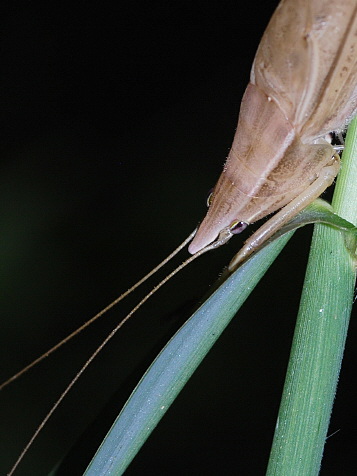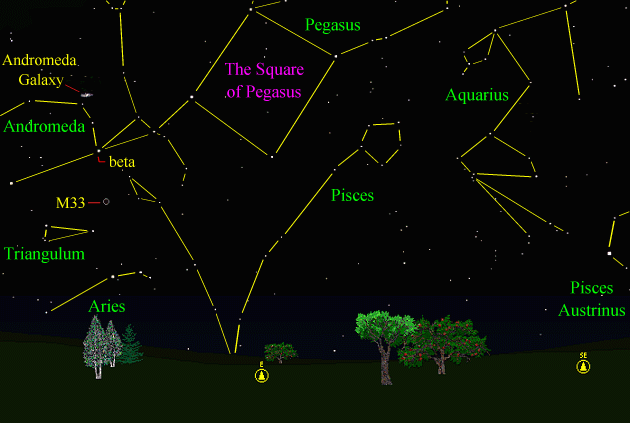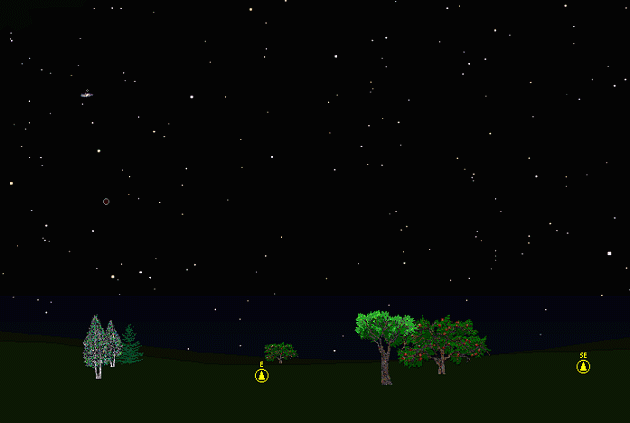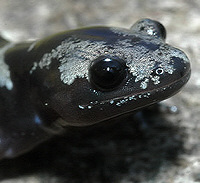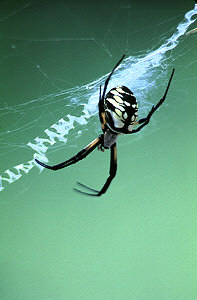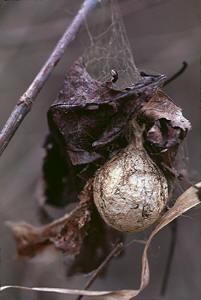The purpose of this feature is to give scout leaders, educators and naturalists an idea of some of the natural events coming up each month. We will try to cover a variety of natural events ranging from sky events to calling periods of amphibians, bird and mammal watching tips, prominent wildflowers and anything else that comes to mind. We will also note prominent constellations appearing over the eastern horizon at mid-evening each month for our area for those who would like to learn the constellations. If you have suggestions for other types of natural information you would like to see added to this calendar, let us know! Note: You can click on the hyperlinks to learn more about some of the featured items. To return to the Calendar, hit the "back" button on your browser, NOT the "back" button on the web page. All charts are available in a "printer friendly" mode, with black stars on a white background. Left clicking on each chart will take you to a printable black and white image.
Notes and Images From August 2008
The galaxy NGC 7331 rises with Pegasus, the Winged Horse. The great spiral eluded detection by the French comet hunter Charles Messier, and is not included in his famous catalog of comet look-alikes. But Messier perhaps contributed to its discovery. William Herschel was a musician who became interested in astronomy at age 35. On March 13th, 1781, when he was 43, Herschel achieved fame and fortune by discovering the planet Uranus. He was given an annual grant by King George III, quit his day job, and was elected to the Royal Society on December 7th of the same year. That same day a friend, William Watson, presented Herschel with a copy of the just-published Messier Catalog. Until then Herschel had observed only 4 nebulae. The copy of the Messier Catalog stimulated Herschel's interest in making a systematic search for these objects. Over the next 20 years, with the assistance of his sister Caroline, Herschel discovered more than 2,500 new star clusters nebulae, and galaxies. His son John added many more, and in 1864 published the "General Catalogue of Nebulae." This catalog became the basis for the New General Catalog (NGC) used today. Herschel I.53, now known as NGC 7331, was discovered by William Herschel in 1784. NGC 7331 is about 50 million light-years away and 130,000 light-years in diameter. The core of the galaxy is believed to harbor a massive black hole. The inner spiral arms seem to be warped relative to the outer arms, and there is an interesting ellipsoidal glow extending along the polar axis of the galaxy. The brighter galaxies in the background are believed to be around 500 million light-years distant, and the faintest background galaxies are probably much farther away than that. This impressive galaxy can be seen in small amateur telescopes, and under very dark skies, in large binoculars.
We encountered this Nebraska Conehead at our farm. Coneheads are in the insect family Tettigoniidae, which includes the Katydids. Although their brown and green colors blend in well with vegetation, Coneheads can be found by following their conspicuous calls. They produce these calls by rubbing parts of their bodies together. A "file" located at the base of one wing is drawn across a "scraper" located at the base of the other. Nebraska Coneheads make a raspy call lasting around one and one-half seconds. To hear this one, click here. The name Nebraska Conehead is a little misleading, as this species ranges south from Nebraska to Mississippi and east as far as Maryland. Favored habitats include weedy edges of fields and woods, along roadsides, and in brushy ground cover in open woods.
Those who make use of the Frog and Toad ID Pages and the Checklist of Tennessee Amphibians and Reptiles will see quite a few changes in the scientific and common names for these animals. These changes reflect official name changes made earlier this year . Gone are the familiar genera Bufo and Rana, and Upland Chorus Frog is back as a common name. We have updated all parts of the website to reflect these changes.
Sky Events for September 2008: The Autumnal Equinox, marking the beginning of fall in the Northern Hemisphere, occurs on September 22nd at 10:44 CDT. Evening Sky: At the beginning of September Mars, Mercury and Venus are all just above the horizon after sunset. Only Venus is easy to spot without binoculars, however. Watch for Venus to appear higher in the twilight sky as the month progresses. Jupiter shines brightly in the south at dusk, outshining every other star-like object in the southern sky. Use binoculars to watch the four "Galilean" moons change position each night. Steadying the binoculars against a solid object will allow you to see them better. Any small telescope will give you an interesting view. Morning Sky: Watch for Saturn to reappear in the morning twilight in the latter half of the month. On the morning of September 27th, Saturn will be about 5 degrees left of a thin waning crescent Moon. Look for this striking pair about an hour before sunrise. The rings of Saturn are now only about 4 degrees from edge-on. All times noted in the Sky Events are for Franklin, Tennessee and are Central Daylight Time. These times should be pretty close anywhere in the mid-state area. Constellations: The views below show the sky looking east at 10:00pm CDT on September 1st. The first view shows the sky with the constellation outlined and names depicted. Star and planet names are in yellow. Constellation names are in green. The second view shows the same scene without labels. Pegasus appears higher above the eastern horizon this month, as does Andromeda. Look above beta Andromedae and see if you can pick out the faint glow of the Andromeda Galaxy, 2.5 million light years away! City dwellers may need binoculars to pick it out. To get the best view, wait till the square is high overhead to look. If you find the Andromeda Galaxy, you might want to try and see if you can see M33, another nearby galaxy in Triangulum. the Triangle. It will appear in binoculars as a very faint indistinct patch of light. Find the "Square of Pegasus" and work your way outward to the constellations around it.
On Learning the Constellations: We advise learning a few constellations each month, and then following them through the seasons. Once you associate a particular constellation coming over the eastern horizon at a certain time of year, you may start thinking about it like an old friend, looking forward to its arrival each season. The stars in the evening scene above, for instance, will always be in the same place relative to the horizon at the same time and date each September. Of course, the planets do move slowly through the constellations, but with practice you will learn to identify them from their appearance. In particular, learn the brightest stars for they will guide you to the fainter stars. Once you can locate the more prominent constellations, you can "branch out" to other constellations around them. It may take you a little while to get a sense of scale, to translate what you see on the computer screen or what you see on the page of a book to what you see in the sky. Look for patterns, like the stars that make up the "Square of Pegasus." The earth's rotation causes the constellations to appear to
move across the sky just as the sun and the moon appear to do. If you go
outside earlier than the time shown on the charts, the constellations will be
lower to the eastern horizon. If you observe later, they will have climbed
higher. As each season progresses, the earth's motion around the sun causes the constellations to appear a little farther towards the west each night for any given time of night. If you want to see where the constellations in the above figures will be on October 1st at 10:00pm CDT, you can stay up till midnight CDT on September 1st and get a preview. The westward motion of the constellations is equivalent to two hours per month. Recommended: Sky Publishing has just come out with a beautiful and compact star atlas, Sky & Telescope's Pocket Star Atlas. It is destined to become a classic, and is a joy to use at the telescope. A good book to learn the constellations is Patterns in the Sky, by Hewitt-White. You may also want to check out at H. A. Rey's classic, The Stars, A New Way to See Them. For skywatching tips, an inexpensive good guide is Secrets of Stargazing, by Becky Ramotowski. A good general reference book on astronomy is the Peterson
Field Guide,
A Field Guide to the Stars and Planets, by Pasachoff. The book retails for around $14.00. Starry Night has several software programs for learning the night sky. Visit the Starry Night web site at www.starrynight.com for details.
Amphibians:
The frog and toad choruses start waning in September but some frogs and toads are still calling. Another name for the Spring Peeper is the "Autumn Piper", and these small frogs can be heard calling from patches of woods in the fall. Listen also for a very dry, scratchy version of the Upland Chorus Frog's song on rainy days and nights in September. On cooler September nights, Southern Leopard Frogs sometimes call and breed as the cooler temperatures mirror their early spring breeding period. We've already heard Southern Leopard Frogs at our pond in August. You can locate many of the frogs and toads that have been calling more frequently earlier in the year by driving the back roads slowly on rainy nights.
This is a two person job. One person watches the road for amphibians and one person looks out for other vehicles. Anything over about 15mph is "speeding." On wet nights in September, look for breeding Marbled Salamanders in flooded woodland areas. We found one such area where we had previously heard a breeding chorus of Upland Chorus Frogs.
Birds: Fall migration reaches its peak as September progresses. Be sure to check around ponds, river banks and on exposed mud flats for shorebirds, as many pass through Tennessee in the fall. Hawks peak around the third week in September, and you might want to consider a hawk-watching trip. For good locations, see Bird Finding in Tennessee, below. A trip to the banks of the Mississippi River this time of year can yield numerous shorebirds and large flocks of White Pelicans migrating overhead (we saw 58 birds in one flock in the fall of 2001), and Least Terns flying up and down along the river. Recommended: Bird Finding in Tennessee, Michael Lee Bierly. A classic guide to finding birds in Tennessee. The Sibley Guide to Birds, David Allen Sibley The Sibley Guide to Birds of Eastern North America, David Allen Sibley An inexpensive guide for beginners is the Golden Guide for Birds.
Spiders:
Early fall is a great time to observe spiders. One commonly seen spider this time of year is the beautiful Black-and-Yellow Argiope. The body length on the female Argiopes can range up to 1-1/8 inches long. You can sometimes spot the much smaller male Argiope (body length only about 3/8" long) at the edges of the female's web. Black-and-Yellow Argiopes are quite beneficial and feed on a wide variety of flying insects such as aphids, flies, grasshoppers, wasps and bees. Although these spiders may bite when harassed, their venom apparently does not cause problems for humans. Their webs have a characteristic zigzag pattern in the center (see the photo) called the "stabilimenta," so named because it was first thought to provide structural stability for the web.
One competing hypothesis is that the highly visible threads prevent birds from flying through the webs. After mating, the female Black-and-Yellow Argiope produces one or more papery egg sacs. These sacs (Charlotte's "magnum opus" in the book Charlotte's Web, though Charlotte was a Barn Spider) are round and up to an inch in diameter. Each sac contains from 300 to 1400 eggs. The male dies soon after mating, but the females survive until the first hard frost. The young spiderlings hatch in the fall, but overwinter in the sac and do not emerge until the spring. It's interesting to think about them riding out the winter storms in their protective home.
Archives (Remember to use the back button on your browser, NOT the back button on the web page!) Natural Calendar February 2008 Natural Calendar December 2007 Natural Calendar November 2007 Natural Calendar September 2007 Natural Calendar February 2007 Natural Calendar December 2006 Natural Calendar November 2006 Natural Calendar September 2006 Natural Calendar February 2006
Natural Calendar
December 2005
Natural Calendar
November 2005
Natural Calendar
September 2005
Natural Calendar
February 2005
Natural Calendar
December 2004
Natural Calendar
November 2004
Natural Calendar
September 2004
Natural Calendar
February 2004
Natural Calendar
December 2003
Natural Calendar
November 2003
Natural Calendar
September 2003 Natural Calendar February 2003 Natural Calendar December 2002 Natural Calendar November 2002 Nature Notes Archives: Nature Notes was a page we published in 2001 and 2002 containing our observations about everything from the northern lights display of November 2001 to frog and salamander egg masses. Night scenes prepared with Starry Night Pro software All images and recordings © 2008 Leaps |

